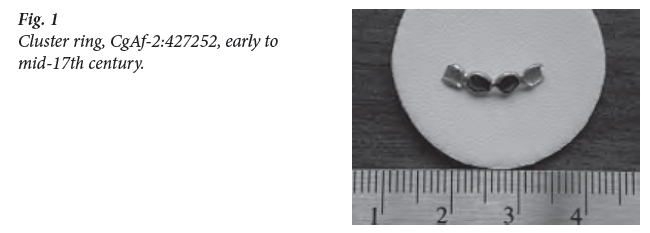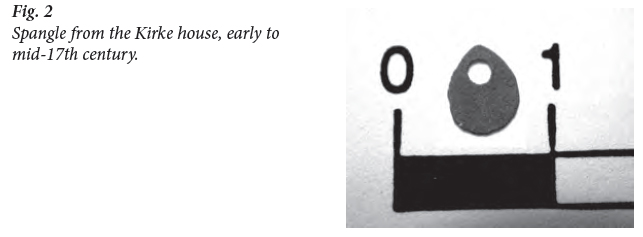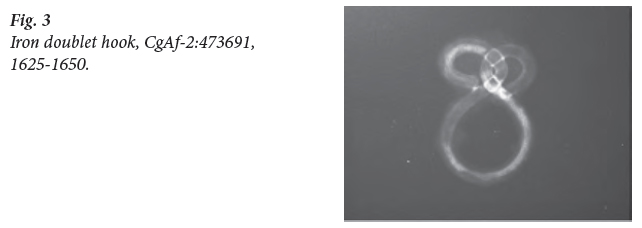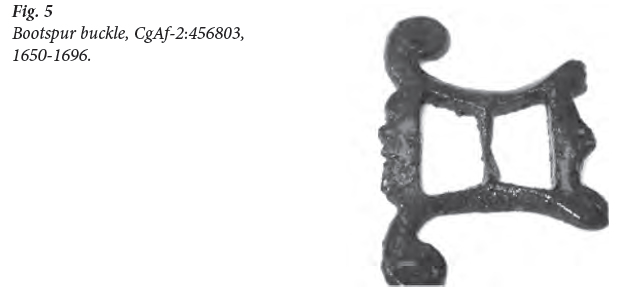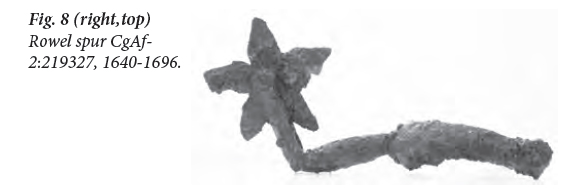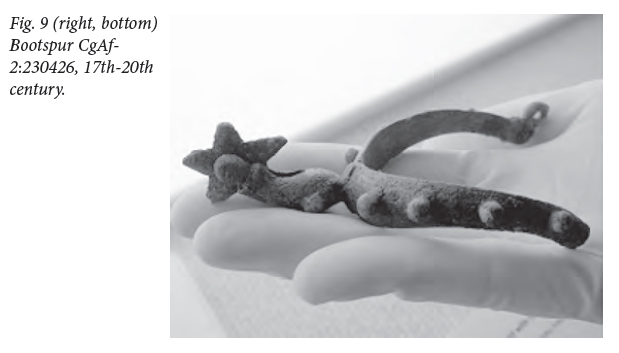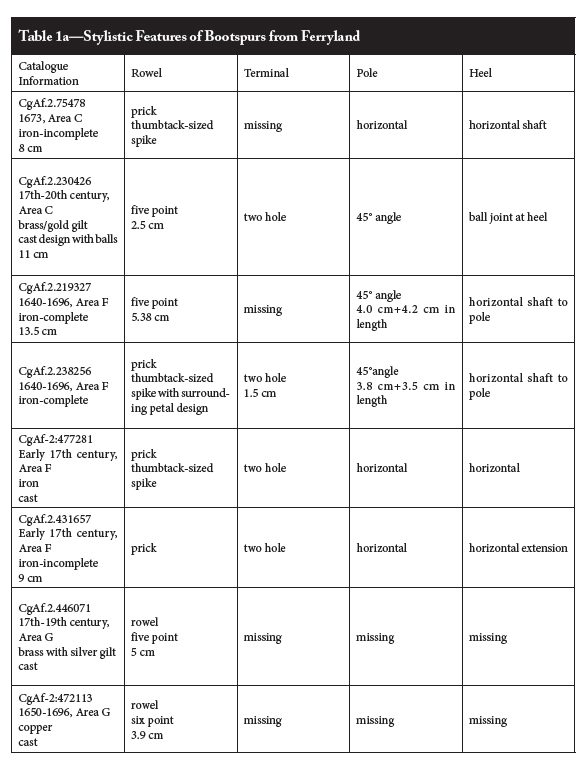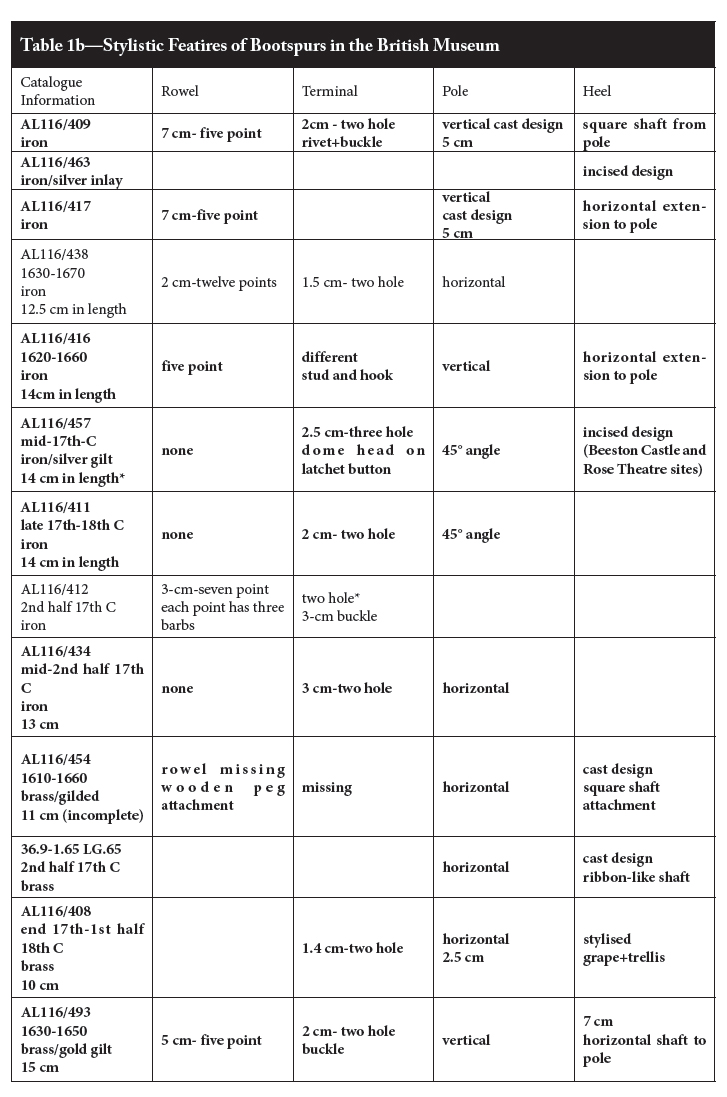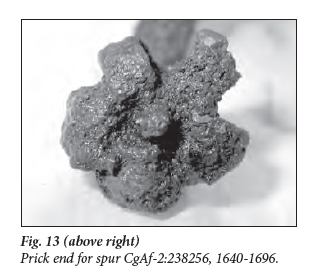Research Reports
Bootspurs of the Early Modern Period Newfoundland
Abstract
For researchers of art history or archaeology of the early modern period, evidence must be viewed through a multidisciplinary eye in order to understand all aspects of culture. Objects which become popular as a costume component can serve as markers for change in culture. This paper will demonstrate the value of one such marker, the bootspur of the 17th century. Examples are taken from an archaeological site in Ferryland, Newfoundland, and from the British Museum. Note that when using this type of research material, there is an additional limitation, that of burial environment. We may never get the whole story because, depending on the material of manufacture, some objects will survive burial and others will not.
Résumé
Les chercheurs en histoire de l’art ou en archéologie spécialisés dans les débuts de l’époque moderne doivent porter un regard multidisciplinaire sur les données afin de comprendre tous les aspects de la culture. Les objets qui acquièrent une popularité en tant que composante du costume peuvent servir de marqueurs de changement culturel. Cet article démontrera la valeur de l’un de ces marqueurs, l’éperon du XVIIe siècle. Les exemples proviennent d’un site archéologique, celui de Ferryland, à Terre-Neuve, et du British Museum. Il faut noter que lorsque l’on utilise ce type de matériau de recherche, il existe une limitation supplémentaire, celle de l’environnement des fouilles. Il se peut que nous ne puissions jamais connaître toute l’histoire, en fonction du matériau de fabrication, puisque certains objets survivront à leur enfouissement, et d’autres non.
1 This paper will describe the bootspur of the 17th century. This element of costume for the 1600s was both functional and iconic to the wearer. The bootspurs described are from archaeological contexts, with one group having been found in Ferryland, Newfoundland, and the second having no provenance but being part of the British Museum collection. The 17th-century bootspur was an expensive piece of horse-related hardware; often with gold or silver gilt on a base metal of brass or iron. Few owned this object type, and metals do not survive well in the burial environment; it is therefore rare to find these in the archaeological record. Thus the objects presented here are unique within the context of global museum collections. I therefore encourage researchers and students to further explore the genre of boot spurs from the early modern period. Both collections are accessible by the public.
Metals used for the Bootspurs found at the 17th-century colony of Ferryland
 Display large image of Figure 4
Display large image of Figure 4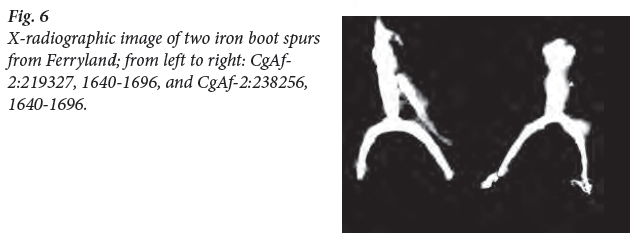 Display large image of Figure 6
Display large image of Figure 62 During the 1600s, from the perspective of material culture found in the archaeological record, it would appear that iron was an important base metal, with gold, silver, and tin being used for surface decoration. Bootspurs from the period were largely made of wrought iron, as were small decorative personal items such as snuff boxes. If we see the Ferryland site as broadly representing much of the 1600s, then we must keep in mind that our interpretation of jewellery is very much affected by the burial environment, as most metals, and, in particular iron, are susceptible to degradation underground. Figures 1 and 2 show personal adornment objects found at the Ferryland, Newfoundland, site. The best type of soil matrix for metal preservation is one which is dry or one that drains easily. Thus high sand and loam concentrations are best, allowing for drainage of ground-water or precipitation. Such an environment is found at the archaeological site in Ferryland. The doublet hook made of iron shown in Fig. 3 (X-ray) is one of a few objects of this type which have survived. That is why fragile objects, as in Figs. 4 and 5, which are not usually found in an archaeological context, give a different view to the 17th century, simply because they have survived while most have not. This site, being untouched for centuries, provides excellent context for understanding the evolution of material culture of the early modern period.
Changes of Style
3 For researchers, one of the most useful aspects of costume is the way in which style changes over time. These changes facilitate the use of these artifact types for dating purposes. This object type, if found with a known context in the archaeological burial environment, can aid in the interpretation of the site; for example, Figs. 6 to 8. That said, from the work of art historians we know that costume style changes can be a useful tool for presenting aspects of the self or commenting on cultural change. Thus, the style might represent the 1620s but be used in the 1720s as a commentary on current cultural change. Similarly, because these objects generally have a higher monetary value they are kept and passed along to other; so the context in which they are found can represent other aspects of culture beyond ownership (or original ownership). These variables, added to the degradation of material caused by the burial environment, impart great significance to any positive identification, or matching of artifacts between institutions, that are achieved. The following description of the archaeological site provides context to the Ferryland bootspurs.
The Site
4 The areas of excavation relevant to this discussion include three areas of domesticated structures and one of a waterfront warehouse. Costume-related artifacts recovered at the waterfront area are predominantly small finds, such as buttons that might have been lost from garments worn within this working area of the site. Overall, the waterfront appears to be early 17th century. Domestic structures date to the second half of the 17th century and have been described as houses occupied by residents of the middling class (Nixon 1999: 57-95; Crompton 2000: 1-48), and the associated costume-related material culture generally supports these conclusions. In the area described by Crompton, though, an exception was found. Three scraps of wool, each containing a buttonhole bound with silver metal threads (CgAf-2:78983), appear to be early 17th century. These objects are in themselves odd; the fact that they had been cut out from the original garment for recycling may indicate that their owner was of a status below that of the gentry. This could also explain the discrepancy in date. Overall though, using costume-related objects to provide context can be extremely problematic. What is possibly the most elite of the domestic areas, described by Tuck and Gaulton (2001: 104), dates to the second half of the 17th century. To support this designation is the finding of luxury goods such as tin-glazed ceramic vessels and terra sigillata earthenwares. In addition, six pipe bowls bearing the initials “DK”, and a lead “DK” token, were found in this area, making researchers believe this to be the residence of Sir David Kirke, proprietor of the “Pool Plantation” from 1638 to 1651 (Tuck and Gaulton 2001: 104). Fancy objects of costume were found in this area, including two gold rings, silver-plated iron bootspurs, a silver thimble and bodkin, and numerous tin-plated copper pins, which may provide sufficient evidence to confirm that this was the primary Kirke residence in 17th-century Ferryland. The bootspur evidence from this area will be used here to compare to bootspurs in the collection of the British Museum.
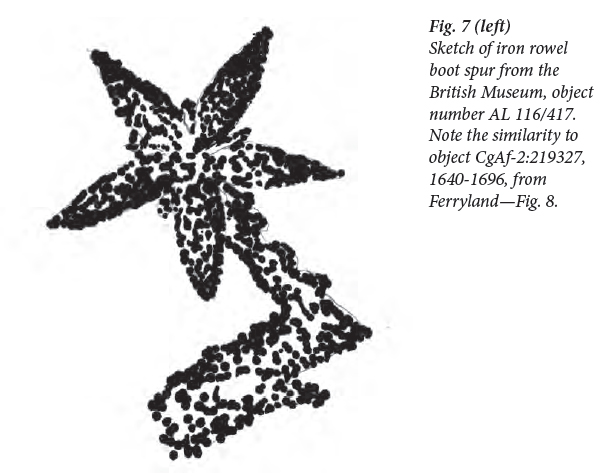 Display large image of Figure 7
Display large image of Figure 7Comparison of the Ferryland Bootspurs with the British Museum Collection
5 A survey of thirty-one 17th-century bootspurs in the collection of the British Museum, London, was undertaken to identify stylistic changes through the century. Unfortunately, few samples had precise provenance, with the majority simply identified as being from the 1600s. A possible place of manufacture could have been Milan (Shesgreen 2002: 28). Stylistic differences in the rowel (rotating star section), terminal (section of loops or hooks allowing bootspur to be attached to boot), and orientation of the pole (metal shaft onto which the rowel attaches) were identified within the British Museum and Ferryland collections, and are summarized in Tables 1a and 1b.
6 The Ferryland collection holds eight individual bootspurs. Five of these represent either complete or fairly complete bootspurs, while three examples comprise only the rowels. Each of these last three shows evidence of wear, and each was likely discarded because it no longer functioned properly. Each of the eight displays stylistic and material variation. The first brass-and-gold-gilt bootspur (CgAf-2:230426, Fig. 9), with its 2.5-cm, five-point rowel, resembles British Museum objects AL116/400 and AL116/404. The first British Museum example was assigned a date range of 1600-1660, while the second probably dates to the 1630s, and certainly fits within the 1600-1650 range. The Ferryland example was found in a deposit associated with the Kirke house (1640s-1696). Ceramic shards from this midden have also been identified as dinnerware from the first half of the 17th century (Stoddart 2000: 49-99). The examples identified in the British Museum collection, as well as the archaeological evidence, indicate that this particular bootspur can be assigned a date range of 1600-1660.
7 Iron bootspur fragments from Ferryland could match with those from the British Museum as follows: Figure 10 is a sketch of a boot spur from the British Museum showing the terminal ends. X-radiography of artifact CgAf-2:75478 (Fig. 11) has similar terminal ends. Figures 12 and 13 shows a prick spur CgAf-2:238256, which dates to the mid 17th century. These bootspurs resemble bootspurs AL116/411, AL116/434, and AL/463 from the British Museum. Objects AL116/434 and AL116/416 date to the mid 17th century, while AL116/411 dates to the late 17th century. British Museum samples AL116/409, AL116/416, and AL116/417 are similar to iron bootspur CgAf-2:219327 (Figs. 4 and 6), dating to the mid-17th century.
8 Noël Hume suggests that during the first half of the 17th century, bootspurs were mostly made of iron (Noël Hume 1969: 243). Brass spurs were also used at this time but tended to be very fancy, with elaborate chased design and gold gilt. They had large rowels and elbowed shanks and poles. The most common type of bootspur had a straight shank with a small thumbtack-sized spike or prick instead of a rowel. Based on the boot-spurs recovered at Ferryland, it seems likely that object CgAf.2.238256 was made of iron and was used by someone of the middling sort, while the fancier brass spur was used by one of the gentry. The iron spur with a five-point rowel was probably covered with silver or gold gilt, as fragments of this layer are visible today. The style of this example compares well with those in the British Museum collection, which date from the middle to end of the century. The appearance of smaller rowels has been associated with the latter half of the 17th century and early 18th century. The smaller rowel of brass bootspur CgAf-2:230426 (Fig. 9) could indicate a late-17th-century date; however it resembles bootspurs from the British Museum collection dating to the mid 17th century. Although based on only a few samples, it appears that bootspurs were worn throughout the 17th century in Ferryland, and that they were kept and recycled with changes in fashion.
9 Though this report presents an important costume component of the 17th century excavated from known context, further research in this area should include comparisons to both print culture and contemporaneous paintings. The difficulty of using buried objects to understand culture is that not all materials survive in the soil matrix, therefore not all objects used are represented in their true form, or in the right proportion. Additionally, both paintings and, to a lesser extent, prints do not always portray the contemporaneous material culture accurately, perhaps because they are used for purposes of propaganda or education.
10 Finally, the existence of high-status boot-spurs, combined with such material culture as tin-glazed earthenware, leaded glass, silk velvets, silk damask, and the finer woolens of then-new draperies (Mathias, Moffatt, and Murray 2004: 26-41), provides evidence that at least some the inhabitants of the 17th-century site at Ferryland, Newfoundland, lived in wealth and luxury. The stories behind this make it a site worthy of further research.
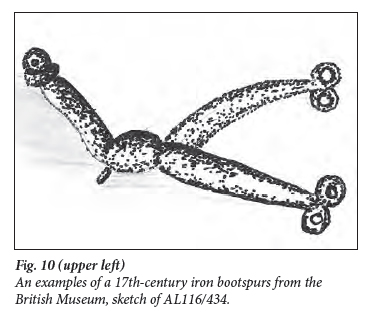 Display large image of Figure 10
Display large image of Figure 10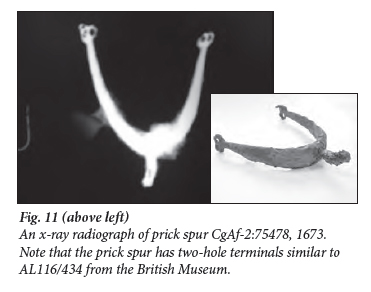 Display large image of Figure 11
Display large image of Figure 11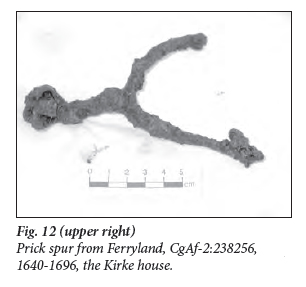 Display large image of Figure 12
Display large image of Figure 12